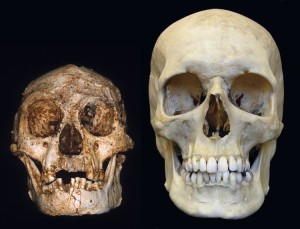Ancient “Hobbit” Origins
Thursday, May 11th, 2017May 11, 2017
A recent anatomical study of Homo floresiensis, a miniature ancient species of prehistoric people, strongly suggests they are not directly related to modern humans. The study, led by Australian National University school of archaeology and anthropology researcher Debbie Argue, found there was no evidence that the diminutive H. floresiensis descended from the much larger Homo erectus, a regional contemporary human species of H. floresiensis. Many scientists believe H. erectus was a direct ancestor to later humans, including all living people today. Argue and her research team’s findings were published last month in the Journal of Human Evolution.

The skull of Homo floresiensis, at left, is much smaller than that of a modern human, shown on the right. Recent research suggests H. floresiensis is a unique species unrelated to modern humans. Credit: © AFP/Getty Images
First discovered in 2004, H. floresiensis is a species of prehistoric human that is strikingly small in stature. The species is known only from skeletal remains discovered on Indonesia’s Flores Island in Southeast Asia. The bones show that adults in this population were little more than 3 feet (90 centimeters) tall. Adults also had a brain about one-third the size of a modern human brain. The species was nicknamed “hobbits” after the short people in the fiction of English author J. R. R. Tolkien.
Previous to this most recent study, many researchers suspected that H. floresiensis descended from a group of early human beings, probably H. erectus, that had dispersed from Africa more than 1 million years ago. The scientists theorized that a group of H. erectus became isolated on remote Flores island long ago and gradually evolved (developed over time) a smaller body size. They may have died out when physically modern humans arrived on the island.
However, the new study findings show that H. floresiensis was probably descended from a far more primitive ancestor than H. erectus. The study indicates that another species of early humans, called Homo habilis, is a more likely ancestor to the Flores “hobbits.” H. habilis is the most ancient member of the genus Homo, the scientific name for the group of species that includes modern humans. H. habilis is known from fossils in Africa that date from about 2.4 million years ago to about 1.7 million years ago. Yet, to date, no fossils of H. habilis have been discovered beyond the African continent. Many scientists believe that H. habilis did not possess the intelligence or technology necessary to migrate into new environments outside of their homeland. If the hobbits of Flores Island—some 5,600 miles (9,000 kilometers) from Africa’s east coast—are indeed descendants of H. habilis, then scientists will have to reevaluate their ideas about H. habilis as they continue to study and learn about prehistoric peoples.


